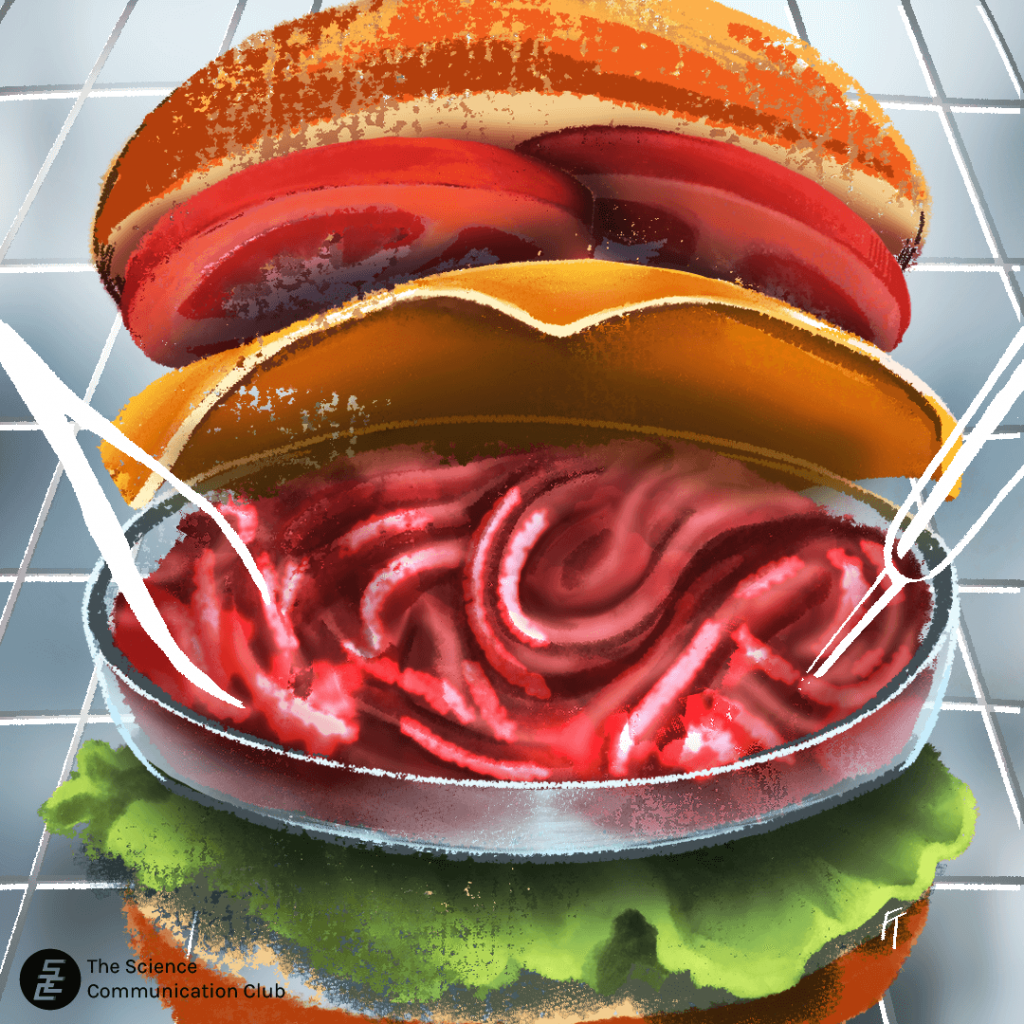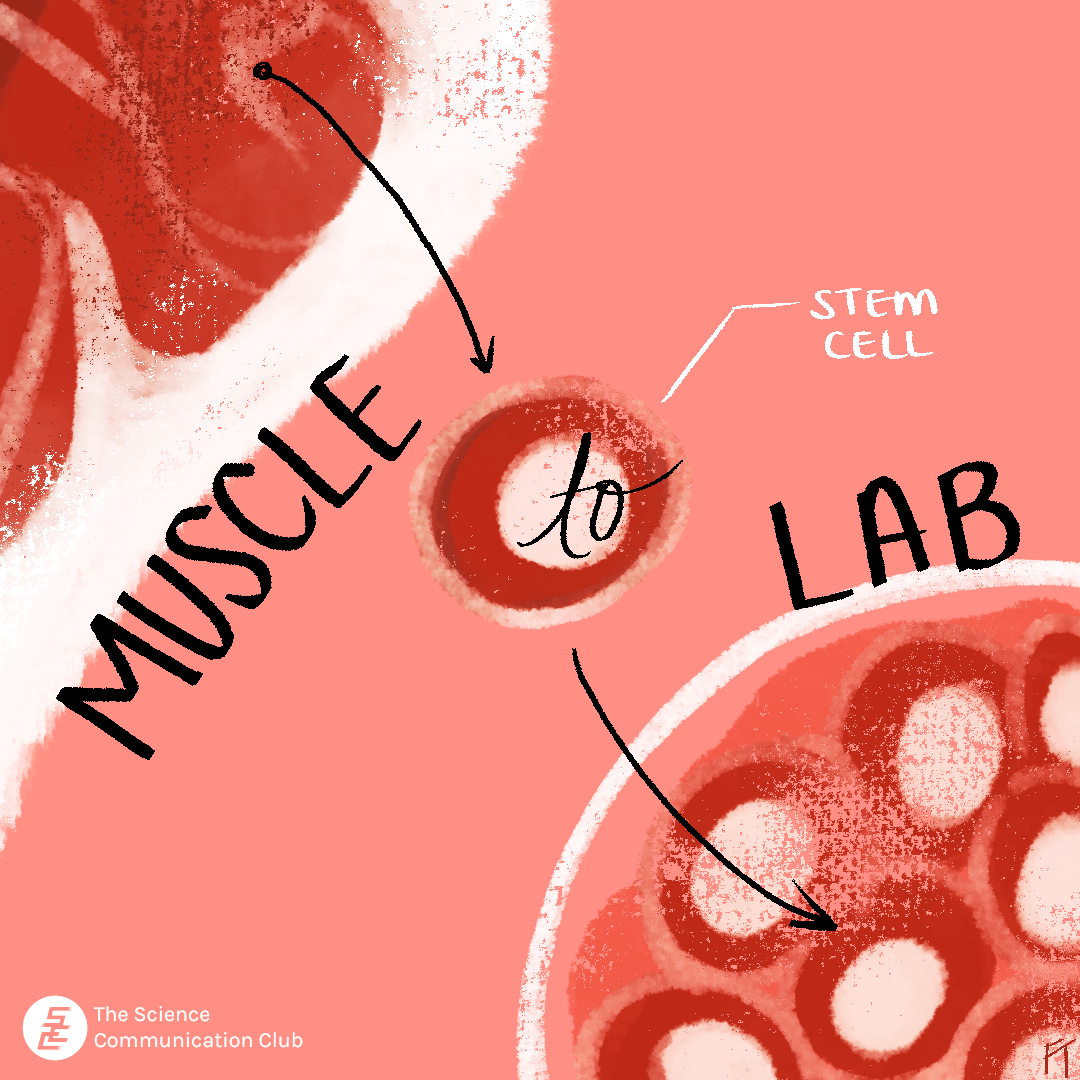
Written by Trisha Mahtani
Illustrated by Fiona Tung
As the population of the world continues to grow past 7.3 billion people, food demand will continue to increase. Agriculture and farming that produce various meats like beef are large contributors to greenhouse gas emissions (around 15%!) that are accelerating climate change. Climate change is also problematic for meeting food demand, as increasing temperatures reduce crop yields. Taken together, this highlights our need to find sustainable ways to produce large amounts of food with less environmental impact. In addition to the environmental impacts, farming livestock requires the use of many antibiotics, which is not ideal when many bacteria are becoming antibiotic resistant, making it harder to treat bacterial infections in both livestock and humans. Reducing the production of livestock for meat consumption would be beneficial to avoid these imminent dangers, and this is where “lab-grown” or “cultured” meat could be helpful.
Lab-grown meat is cultivated from beginning to end in a laboratory setting. It begins with single cells, known as stem cells, which can be taken from the muscle of a live animal. Stem cells are special cells that can become muscle cells in the right environment. These stem cells are grown in a laboratory and provided with a nutrient-rich liquid containing environmental cues that are required for development, such as hormones and other molecules. The nutrient rich conditions allow for these cells to grow and multiply and this can be done in large volumes using a bioreactor, which is a large stainless-steel tank that supports cell growth. Cell growth is a stepwise process where a specific cell to volume ratio is needed for cells to thrive and grow happily. This requires the cell and liquid mixture to be moved to bigger and bigger bioreactors as the cells continue to divide, and the volume of liquid is increased over time. Bioreactors can hold up to 25,000 litres of liquid, allowing for quite a large number of cells to grow! This increase in volume also helps dilute the accumulating waste products produced by the growing cells. If there is a high concentration of waste products, the cells will no longer grow.

When lab-grown meat was first introduced in 2013, scientists were only able to generate something that resembled minced meat. While this was great for burgers, improvements were required to generate something like a steak. Scientists discovered that using a material that could act like a mold or a scaffold allowed for the generation of larger and longer meat strands. Essentially, newly generated muscle cells are moved onto a mold or scaffold that enhances their growth. It provides nutrients, movement and a structure for these cells to grow around. Growing muscle cells can come together to form a muscle fibre and eventually even contract like real muscle! However, one of the issues that arises with growing lab-based meat is that typical cuts of meat that we purchase are made of a network of muscle and fat cells with blood vessels, nerves and bone. By just growing stem cells from muscle, it is not possible to replicate a complete steak or chicken leg. However, scientists are working towards improving tissue engineering, so someday it might become a reality!
The cost of producing lab-grown meats is quite high. In Singapore, you can now purchase nuggets that are 70% lab-grown chicken but each one costs $50!! Bringing down the cost of lab-grown meat is a challenge, as better technology and much larger production facilities are required. However, there are limits to scaling up production: bioreactors larger than 25,000 litres have not yet been successful in growing meat, cells that grow fast produce more waste, and very sterile conditions are required to avoid bacterial contamination. Sterile work environments significantly contribute to plastic waste and may have a larger carbon footprint than expected, which reduces the net environmental benefits of lab-grown meat.
Hopefully, advances in technology and research will soon allow for reasonably priced, environmentally friendly large-scale production of lab-grown meat. Many companies are already working towards creating sustainable and cost-effective solutions. They are also trying to reduce the cost and amount of the nutrient-rich media required for cell growth. With constant progress on all fronts, making lab-grown meat a reality may happen sooner than later. Perhaps in 10 years we’ll all be eating lab-grown chicken nuggets from the comfort of our homes!
Sources:
- Bokat-Lindell, S. (2021, October 14). Can Lab-Grown Burgers Help Stop Climate Change? The New York Times Opinion. https://www.nytimes.com/2021/10/14/opinion/climate-change-lab-grown-burgers.html
- Chriki, S. and Hocquette, J-F. (2020). The Myth of Cultured Meat: A Review. Frontiers in nutrition, 7, 7. https://doi.org/10.3389/fnut.2020.00007
- Cline, WR. (2007). Global warming and agriculture: Impact estimates by country. Finance & Development, 45(1), 23-27. https://doi.org/10.5089/9781451922349.022
- Dolgin, E. (2020). Will cell-based meat ever be a dinner staple? Nature, 588, 64-67. https://doi.org/10.1038/d41586-020-03448-1
- Fassler, J. (2021, September 22). Lab-grown meat is supposed to be inevitable. The science tells a different story. The Counter. https://thecounter.org/lab-grown-cultivated-meat-cost-at-scale/
- Mohatarem, K. F. (2021, April 7). Edmonton startup aims to make lab-grown meat more affordable. CBC News. https://www.cbc.ca/news/canada/edmonton/edmonton-startup-aims-to-make-lab-grown-meat-more-affordable-1.5976875
- Muraille, E. (2019, November 28). ‘Cultured’ meat could create more problems than it solves. The Conversation. https://theconversation.com/cultured-meat-could-create-more-problems-than-it-solves-127702
- Oliver, S. P., Murinda, S. E., Jayarao, B. M. (2011). Impact of antibiotic use in adult dairy cows on antimicrobial resistance of veterinary and human pathogens: a comprehensive review. Foodborne pathogens and disease, 8(3), 337-355.
- World’s first lab-grown burger is eaten in London. (2013, August 5). BBC News. Retrieved October 20, 2021, from https://www.bbc.com/news/science-environment-23576143.